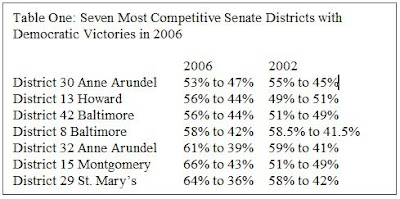Unfortunately for the Maryland GOP, five seats may simply be too tall of an order. A review of district by district election results from 2002 and 2006 shows that there are very few truly competitive districts for the GOP to target (Table One). In 2006 there was only one district where a Democrat won by less than a 10 point margin – district 30 in Anne Arundel County. The next 6 most competitive races were all decided by decisive margins. The election in 2006 represented a high water mark for Democrats nationally and in the state, so I looked to 2002 as well. In 2002 Republicans did very well nationally and Bob Ehrlich won the governor’s race. Even in 2002, however, there were only 3 races decided by a margin of less than 10 points – District 13 in Howard County, District 42 in Baltimore County, and District 15 in Montgomery County. None of those districts were close to being competitive in 2006. If the GOP truly hopes to pick up 5 seats they will have a very hard time identifying good targets. They may have to rely on unexpected retirements, primary challenges, or the sudden arrival on the agenda of a politically divisive issue to weaken Democratic incumbents. In addition, Republicans scored only narrow victories in District 3 in Frederick County and District 31 in Anne Arundel in 2006 - so they would need to pick up 5 Democratic seats AND defend all of their own.
When Scott Brown was running to succeed Ted Kennedy to the U.S. Senate in Massachusetts he campaigned on the pledge to be “number 41.” Meaning that he would be the crucial 41st vote to deny Senate Democrats their filibuster-proof majority. All indications are that the tactic worked. Maryland Republicans may want to emulate the Brown approach, but it’s a harder case to make when candidates would need to proclaim “I’m number 15, and I’m number 16, and I’m number 17…” Reaching 19 votes would likely revitalize the Maryland GOP and bring some much needed checks and balances to the state's one party rule, but the bar may be too high. Although any number closer to 19 would mean one less Democrat that the GOP would need to convince to join a filibuster effort. In the end, if Maryland Republicans are to have any hope of reaching the magic number of 19 they’ll need a strong candidate at the top of the ticket (and there is only one candidate who fits that description) and a GOP wave nationally to carry them over the line.


